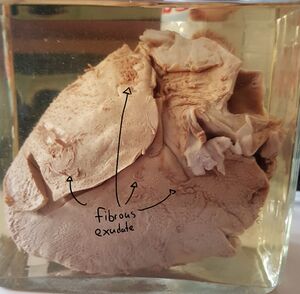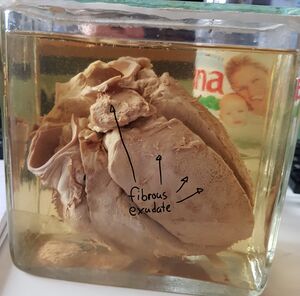25. Fibrinous pericarditis – cor villosum: Difference between revisions
mNo edit summary Tags: Mobile edit Mobile web edit Visual edit |
No edit summary |
||
| Line 17: | Line 17: | ||
'''Theory''': | '''Theory''': | ||
Fibrinous pericarditis is a type of fibrinous acute inflammation. The exudate is fibrinous, meaning that it contains fibrin. ''It should say fibrinous on the pictures as well.'' | Fibrinous pericarditis is a type of fibrinous acute inflammation. The exudate is fibrinous, meaning that it contains fibrin. ''It should say fibrinous on the pictures as well. Fibrous means "consisting of fibres" and is a term used for another type of tissue.'' | ||
[[File:Cor villosum other side.jpg|thumb|Cor villosum other side]] | |||
[[File:Cor villosum one side.jpg|center|thumb|Cor villosum one side]] | [[File:Cor villosum one side.jpg|center|thumb|Cor villosum one side]] | ||
[[Category:Pathology 1 - Macropreparations]] | [[Category:Pathology 1 - Macropreparations]] | ||
Latest revision as of 11:35, 5 July 2024
Organ: Heart + pericardium
Description:
Everywhere on the surface of the pericardium can a thin, network like diffuse material be seen. In some parts it looks like a spider-web.
Diagnosis: Cor villosum = fibrinous pericarditis
Causes (from most to least common):
- Uraemia
- Infection
- Mostly viral infection, mostly from the coxsackie virus
- Systemic lupus erythematosus
- Rheumatic fever
Theory:
Fibrinous pericarditis is a type of fibrinous acute inflammation. The exudate is fibrinous, meaning that it contains fibrin. It should say fibrinous on the pictures as well. Fibrous means "consisting of fibres" and is a term used for another type of tissue.


